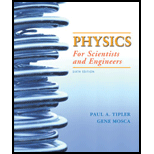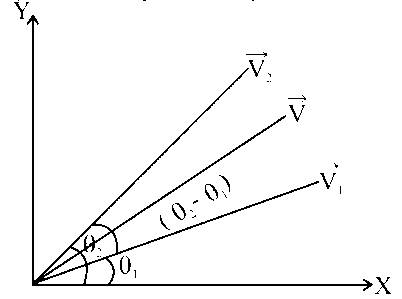
(a)
To Find: The peak current in the circuit using Kirchhoff’s loop rule and trigonometric identity.
(a)
Answer to Problem 27P
Explanation of Solution
Given:
Potential difference across terminals of one of the generators,
Potential difference across terminals of one of the other generators,
Where,
Resistance,
Formula used:
Kirchhoff’s Voltage law:
Sum of the potential in a closed loop circuit is zero.
Calculation:

ApplyingKirchhoff’s voltage law:
Conclusion:
(b)
To Find: The peak current in the circuit by using a phasor diagram.
(b)
Answer to Problem 27P
Explanation of Solution
Given:
Potential difference across terminals of one of the generators,
Potential difference across terminals of one of the other generators,
Where,
Resistance,
Formula used:
Vector formula
Where,
Calculation:

Angle between the vectors
Magnitude of
But,
It is given that
Therefore,
Conclusion:
(c)
To Find: The current in the resistor.
(c)
Answer to Problem 27P
Explanation of Solution
Given:
Potential difference across terminals of one of the generators,
Potential difference across terminals of one of the other generators,
Where,
Resistance,
Formula used:
Kirchhoff’s loop rule
Sum of the potential in the circuit is zero.
Calculation:
ApplyingKirchhoff’s loop rule
For,
Therefore,
Conclusion:
The current in the resistor is
Want to see more full solutions like this?
Chapter 29 Solutions
Physics For Scientists And Engineers
- In a purely inductive AC circuit as shown in Figure P21.15, Vmax = 100. V. (a) The maximum current is 7.50 A at 50.0 Hz. Calculate the inductance L. (b) At what angular frequency is the maximum current 2.50A? Figure p21.15arrow_forwardThe emf of an ac source is given by v(t)=V0sint, where V0=100V and =200 . Find an expression that represents the output current of the source if it is connected across (a) a 20-pF capacitor, (b) a 20-mH inductor, and (c) a 50 resistor.arrow_forwardIn a purely inductive AC circuit as shown in Figure P21.15, Vmax = 100. V. (a) The maximum current is 7.50 A at 50.0 Hz. Calculate the inductance L. (b) At what angular frequency is the maximum current 2.50A? Figure p21.15arrow_forward
- An AC generator with an rms emf of 15.0 V is connected in series with a 0.54-H inductor. The frequency of the source emf is 70.0 Hz. Draw a phasor diagram for this circuit, including the current, the potential difference across the inductor, and the source emf. Draw your diagram with the current phasor pointing toward the right along the horizontal axis.arrow_forwardIn the AC circuit shown in Figure P32.3, R = 70.0 and the output voltage of the AC source is Vmax sin t. (a) If VR = 0.250 Vmax for the first time at t = 0.0100 s, what is the angular frequency of the source? (b) What is the next value of t for which VR = 0.250 Vmax? Figure P32.6 Problem 3 and 5.arrow_forwardWrite an expression for the output voltage of an ac source that has an amplitude of 12 V and a frequency of 200 Hz.arrow_forward
- A 40-mH inductor is connected to a 60-Hz AC source whose voltage amplitude is 50 V. If an AC voltmeter is placed across the inductor, what does it read?arrow_forwardFor an RLC series circuit, the voltage amplitude and frequency of the source are 100 V and 500 Hz, respectively; R=500 ; and L = 0.20H . Find the average power dissipated in the resistor for the following values for the capacitance: (a) C=2.0F and (b) C=2.0F .arrow_forwardIn a purely inductive AC circuit as shown in Figure P32.6, Vmax = 100 V. (a) The maximum current is 7.50 A at 50.0 Hz. Calculate the inductance L. (b) What If? At what angular frequency is the maximum current 2.50 A? Figure P32.6 Problem 6 and 7.arrow_forward
 Glencoe Physics: Principles and Problems, Student...PhysicsISBN:9780078807213Author:Paul W. ZitzewitzPublisher:Glencoe/McGraw-Hill
Glencoe Physics: Principles and Problems, Student...PhysicsISBN:9780078807213Author:Paul W. ZitzewitzPublisher:Glencoe/McGraw-Hill Physics for Scientists and Engineers: Foundations...PhysicsISBN:9781133939146Author:Katz, Debora M.Publisher:Cengage Learning
Physics for Scientists and Engineers: Foundations...PhysicsISBN:9781133939146Author:Katz, Debora M.Publisher:Cengage Learning Physics for Scientists and EngineersPhysicsISBN:9781337553278Author:Raymond A. Serway, John W. JewettPublisher:Cengage Learning
Physics for Scientists and EngineersPhysicsISBN:9781337553278Author:Raymond A. Serway, John W. JewettPublisher:Cengage Learning Physics for Scientists and Engineers with Modern ...PhysicsISBN:9781337553292Author:Raymond A. Serway, John W. JewettPublisher:Cengage Learning
Physics for Scientists and Engineers with Modern ...PhysicsISBN:9781337553292Author:Raymond A. Serway, John W. JewettPublisher:Cengage Learning College PhysicsPhysicsISBN:9781285737027Author:Raymond A. Serway, Chris VuillePublisher:Cengage Learning
College PhysicsPhysicsISBN:9781285737027Author:Raymond A. Serway, Chris VuillePublisher:Cengage Learning College PhysicsPhysicsISBN:9781305952300Author:Raymond A. Serway, Chris VuillePublisher:Cengage Learning
College PhysicsPhysicsISBN:9781305952300Author:Raymond A. Serway, Chris VuillePublisher:Cengage Learning





